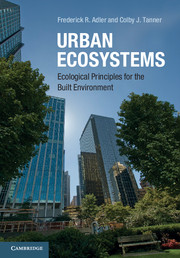1 - Urban ecosystems and the science of ecology
Published online by Cambridge University Press: 05 May 2013
Summary
Every fall, the weather cools, the days shorten, the soil starts to dry, and leaves drop from deciduous trees in temperate regions. These leaves carpet the ground, changing how nutrients and water infiltrate the soil, determining which plants will grow the following spring, altering the insect community, and changing the very scent of the forest. How long these changes persist depends on the availability of water and warmth, and the properties of the leaves themselves, with some being highly resistant to decomposition and others far less so. Sometimes these changes are beneficial for the tree itself, and sometimes they are not. Trees do not drop their leaves in order to create these changes, but the changes come nonetheless, the final consequences of water moved from deep beneath the ground and sunlight captured and stored over the course of an entire summer.
A tree imports energy, water, and nutrients from a relatively small area around and beneath it to achieve ecological and evolutionary success through survival and reproduction. Weather conditions beyond its control force it to drop some of those hard-won imports, creating a whole set of unintended consequences for the tree itself as well as the surrounding ecosystem (Figure 1.1).
- Type
- Chapter
- Information
- Urban EcosystemsEcological Principles for the Built Environment, pp. 1 - 38Publisher: Cambridge University PressPrint publication year: 2013

